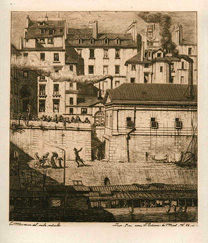|

|
|
La Morgue
Delteil 36,
Wright 36, Schneiderman 42
etching with drypoint, 1854*, on medium-fine cream-yellow laid
paper, with part of a watermark in Roman capitals (COMP), the
4th state (of 7), before the addition of title and date, and
before Delâtre's address, a very fine impression, with
good margins, very faint traces of discolouration in the margins
from an old mount, some slight and quite localized skinning on
the reverse, otherwise in excellent condition
P. 230x206mm., S. 318x293mm.
|
Provenance: the A. F.
Lotz-Brissonneau collection, with the ALB wetstamp in blue on
the reverse (Lugt 83)
Meryon's mastery here
finds its full expression, the ominous billows of smoke set off
against the stark façades backing the riverfront, where
a tiny tragedy unfolds: as a body is carried up, a woman with
her daughter recoils in horror and gendarmes take action before
an entire gallery of onlookers.
It should also be recalled
that this subjet haunted Meryon, who related to Baudelaire (letter
of de 8 January 1860, cited by Delteil), regarding Edgar Poe,
that The Rue Morgue "contains allusions to my own
misfortunes."
With the first inscriptions
added below, the 4th state** is for all practical purposes the
definitive state, and the present impression is quite cleanly
wiped (one of the poor artist's later obsessions), showing rather
fine detail.

* The 5th state comprises
a title and the date of 1850 replacing the prior inscriptions,
although according to Wright this is most likely the date of the
original drawing, now in the Bibliothèque Nationale, Paris.
It should be added that the 4th state impression in the Bibliothèque
Nationale (Ef 397) bearing the wetstamp of the "Dépôt
légal" is also dated 1854.
** Although it predates
the Delâtre address, this state is curiously the most commonly
inventoried by Delteil and Schneiderman, some 50 impressions in
all for the latter: judging by their variety (and knowing something
of Meryon's working methods), they were not all pulled at a single
time nor in a uniform fashion, in spite of the so-called 1852-1854
edition published by Meryon himself for the suite Eaux-fortes
de Paris.

